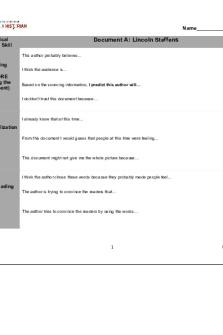Political anthro ANT 101(3).part 2 PDF

| Title | Political anthro ANT 101(3).part 2 |
|---|---|
| Course | understanding culture |
| Institution | University at Buffalo |
| Pages | 1 |
| File Size | 59 KB |
| File Type | |
| Total Downloads | 69 |
| Total Views | 142 |
Summary
lecture notes from the political part 2...
Description
There are no formal institutions and therefore there is no formal legal system. But people can use mechanisms to resolve disputes. Examples from the chapter include duels--these are like rapping duels (p. 4) and ridicule. Disputes can escalate into "war" but this is an informal fight not an organized war (p. 5). Causes for violence often are due to disputes over access to women. Tribes Tribal societies are larger in population size than bands. They have more formal structures of political organization. But there are no centralized political structures. There is no formal means of coercion. The tribal leader, therefore, has to be persuasive. He gains leadership by persuasion. Anyone and everyone can potentially be a leader. Senior men often though are chosen. There is more economic inequality in tribes than in bands, but no one is expected to be deprived of the means of survival. Example of the Big Man in New Guinea. In New Guinea, leaders of tribes are male. Other than that their qualifications can differ by person. "The big man is one who has acquired followers by doing favors they cannot possibly repay, such as settling their debts or providing bride-wealth (wealth needed to get a wife). He might also acquire as many wives as possible to create alliances with his wive's families." (p. 5) It seems the Big Man gains power and influence, as well as status, through his largess (literally). He accumulates wealth in women and pigs. He gains influence by feasting and sharing and shaming the less connected and wealthy members. His generosity helps him gain influence and power. As the author notes, each man must prove his worth. His son, in other words, is not necessarily next in line (p. 5). Sodalities: ways of connecting people outside of kin group, such as by age. Age sets: categories of men assigned membership at birth (like a generation) Age grades: groups of men close in age to each other who share duties and responsibilities Age set example p. 6: Tiriki of Kenya As kids are born they enter into a group. The group closes when it is considered filled. This then becomes an age set. They pass through stages of life with differing roles and duties as a group. see the chart on page 7...
Similar Free PDFs

Ant Essay 2- Chinese culture
- 7 Pages

Midterm 2 Review - Anthro Copy
- 2 Pages

Anthro-1AB3-lecture-notes 2
- 41 Pages

Anthro Midterm
- 10 Pages

Anthro 105
- 7 Pages

Indian Political Thought 2
- 141 Pages

Anthro 101 2 - Lecture notes 2
- 3 Pages

ANT 101 - Passive observation
- 4 Pages

Formes en -ant - samenvatting
- 4 Pages

Informe UP 3 Ant
- 10 Pages

Study Guide 1-1-2 Anthro
- 3 Pages

ANT 385 2.2 - Lecture notes 2
- 4 Pages

Ant and Eclipse
- 2 Pages
Popular Institutions
- Tinajero National High School - Annex
- Politeknik Caltex Riau
- Yokohama City University
- SGT University
- University of Al-Qadisiyah
- Divine Word College of Vigan
- Techniek College Rotterdam
- Universidade de Santiago
- Universiti Teknologi MARA Cawangan Johor Kampus Pasir Gudang
- Poltekkes Kemenkes Yogyakarta
- Baguio City National High School
- Colegio san marcos
- preparatoria uno
- Centro de Bachillerato Tecnológico Industrial y de Servicios No. 107
- Dalian Maritime University
- Quang Trung Secondary School
- Colegio Tecnológico en Informática
- Corporación Regional de Educación Superior
- Grupo CEDVA
- Dar Al Uloom University
- Centro de Estudios Preuniversitarios de la Universidad Nacional de Ingeniería
- 上智大学
- Aakash International School, Nuna Majara
- San Felipe Neri Catholic School
- Kang Chiao International School - New Taipei City
- Misamis Occidental National High School
- Institución Educativa Escuela Normal Juan Ladrilleros
- Kolehiyo ng Pantukan
- Batanes State College
- Instituto Continental
- Sekolah Menengah Kejuruan Kesehatan Kaltara (Tarakan)
- Colegio de La Inmaculada Concepcion - Cebu


